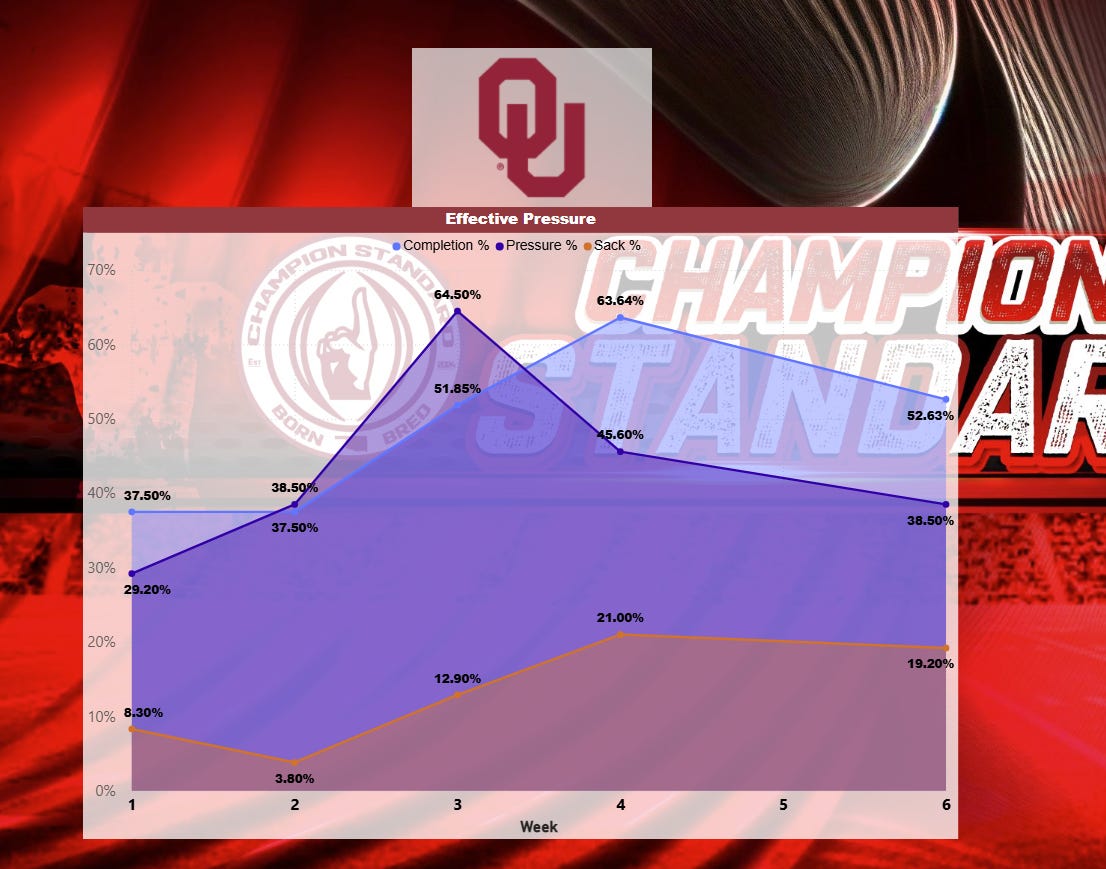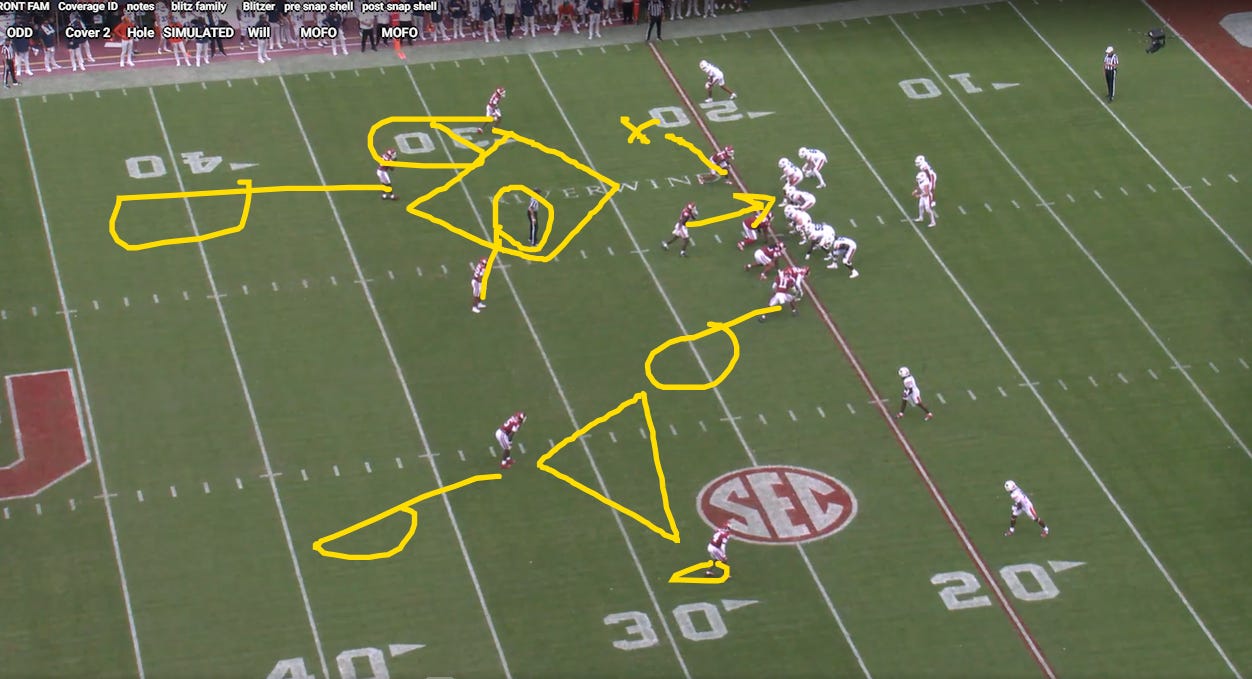Mainstream media, especially on the Texas side, keeps repeating that the offensive line is young, inconsistent, or still developing chemistry. But the truth is, they have been one of the worst offensive lines in the SEC this season. In fact, they may be the weakest unit Oklahoma will face in conference play.
Kyle Flood has coached at two of the most talent-rich programs in college football — Alabama and Texas — during periods of strong institutional support. When he joined Texas in 2021, he inherited a program loaded with NIL resources and recruiting momentum. That gave him access to elite offensive line talent, including Kelvin Banks Jr., a projected first-round pick in the 2025 NFL Draft.
Flood’s previous stint at Alabama came during a dominant era, where he coached behind a Heisman-winning offense and a Joe Moore Award-winning offensive line. While his units have performed well statistically, much of that success came with elite players and favorable conditions already in place.
This season, with four starters needing to be replaced, Texas is experiencing the downside of a Kyle Flood offensive line. Despite starting the same four or five players each week, the group has struggled to find cohesion and consistency.
Also worth mentioning — after attending the 2024 Texas High School Coaches Clinic in San Antonio with some friends, I found Flood’s presentation to be pretty dull and uninspiring
Our D-line is going to feast! No mercy, just chaos.
The Setup
Brent Venables’ Sooners have built their undefeated start on defensive excellence. Oklahoma leads the nation in total defense (193 YPG), passing defense (118.4 YPG), and scoring defense (7.2 PPG). The front seven is relentless, with R Mason Thomas, David Stone, and Jayden Jackson combining for over 7.5 sacks and 12 tackles for loss. Linebacker Kip Lewis anchors the middle with 25 tackles, while Sammy Omosigho and Kendal Daniels bring speed and physicality. The secondary, led by Robert Spears-Jennings and Peyton Bowen, has allowed just one passing touchdown all season.
Texas Offense Profile
Texas’ offense has been explosive at times but inconsistent overall. The Longhorns average 419.2 yards per game (53rd nationally), with 246.6 passing yards and 172.6 rushing yards per contest. Quarterback Arch Manning has thrown for 1,151 yards and 11 touchdowns, but his five interceptions and 60% completion rate reflect a unit still searching for rhythm.
The receiving corps is deep and dangerous. Parker Livingstone leads with 279 yards and three touchdowns, while DeAndre Moore Jr. and Ryan Wingo provide explosive options on the outside. Tight end Jack Endries has emerged as a decent safety valve over the middle. However, the offensive line remains a concern. Texas has allowed 12 sacks through five games, including six in the loss to Florida. This Texas offense does not have a Gunnar Helm or a Jaydon Blue. Two major pieces to every Steve offense is a pass catching back out of the backfield and a TE leaking into the middle field late to stress backers.
No Mercy
Oklahoma’s defensive line is deep, fast, and disruptive. R Mason Thomas is a nightmare at the Edge spot. Jayden Jackson, David Stone and Damonic Williams collapse pockets from the interior. Texas, meanwhile, is replacing four starters from last season and has struggled to protect Manning consistently.
The Sooners rank first nationally in third-down defense (18.8% allowed) and first in yards per play allowed (3.2). Texas must find a way to stay ahead of the chains and avoid obvious passing downs. Brent Venables’ aggression all but guarantees havoc on a grand scale. Manning will be forced into hurried throws and opportunities for mistakes. The Sooners brought 5+ rushers 13 times vs Auburn for 2 sacks. The most efficient pressure type has been our 4-man replacement pressures for 2 more sacks on 4 calls. Replacement pressures are great safe pressures. Rely on disguise, have +2 defenders in coverage, and are translatable into conference play with stiffer competition.
*I exclude penalties in my calculation of 3rd down, Red Zone, and other metrics. That’s one reason why you’ll see some slight differences in my numbers. I exclude because Refs/human element is subjective and comparing accross the country I rather look at pure football plays.**
What the chart and numbers show is a defense evolving into full control of the game. Oklahoma’s pressure rate and sack production were modest to being the year, but entering conference play the Sooners’ pass rush began dictating outcomes. As the visual highlights, the spike in pressure percentage coincided with a steady drop in opponent completion rate, proving how this front’s growth directly impacts coverage efficiency. The line of best-fit through six weeks tells the story: when OU generates heat, quarterbacks fold.
The metrics only reinforce it — Oklahoma is quietly assembling one of the most disruptive defensive stretches in college football, posting a 25% total Havoc Rate (top-5 nationally), meaning one in every four snaps ends with a negative play for the offense. Add in just 2.12 offensive line yards allowed per rush (5th nationally), and it’s clear this defense controls both trenches and tempo. That combination of penetration and discipline defines championship football.
Brent Venables’ defense is fully embodying his trademark mantra of relentlessness and suffocation — and the proof is everywhere: on film, in the numbers, and in the uneasy eyes of every quarterback lined up across from them.
The Film
This isn’t a case of growing pains or a lack of chemistry — it’s flat-out bad football. Pure and simple. Right now, this group looks like one of the worst offensive lines in the SEC.
Cole Hutson spends more time on the ground than a toddler learning to walk.
Goosby forgets his job. Connor Strogh with the high five.
I genuinely don’t know how this Texas offensive line finds any success tomorrow. Florida didn’t even blitz creatively — it was mostly standard four-man pressures — yet Texas still looked completely lost. They show no pre-snap awareness, suffer constant mental breakdowns, and get overpowered at the point of attack. The interior offensive line in particular has been downright awful, struggling with the most basic protection rules.
Run Game Preview
Texas’ run game has been non-existent. CJ Baxter Jr., Quintrevion Wisner, and Jerrick Gibson form a capable trio, but none have cracked 300 yards on the season. Florida held the running backs to 15 yards. Manning himself leads the team in rushing touchdowns with five, often scrambling out of necessity.
Oklahoma’s run defense is stout, allowing just 74.6 rushing yards per game (5th nationally). Texas will need to get creative with zone reads, misdirection, and screen passes to loosen up the front. Texas has to find ways to move the OU defense sideline to sideline to test gap integrity. Playing in a phone booth with OU will only result in getting knocked out.
Everything about this Oklahoma defense is built to stop the run. The corners trap, the safeties key the mesh point, and the defensive line constantly stunts and twists to clog interior lanes. Running the ball on the Sooners simply isn’t a realistic option unless Texas’ playmakers can consistently win against man coverage on the outside. In the Auburn game, the Tigers faced 3rd-and-5 or less four different times — and chose to throw it every single time, a clear sign that teams know better than to test OU on the ground.
Expect Texas to get creative with a horizontal, East–West attack, trying to stretch the field and test Oklahoma’s speed on the perimeter. They’ll likely attempt to wear down the defensive front with sideline-to-sideline plays, forcing the Sooners’ linebackers and corners to chase. It’s hard to imagine much success against this dominant and disciplined Oklahoma front in between the tackles.
Pass Game Preview
Arch Manning has the arm talent to challenge any defense, but Oklahoma’s secondary is disciplined and physical. Arch Manning struggles mightly under pressure. The Sooners have allowed just 51.9% completion and one passing touchdown all season. Manning must be sharp with his reads and avoid bait throws—Peyton Bowen and Robert Spears-Jennings are known for disguising coverage and jumping routes.
Texas will likely test Oklahoma deep early, hoping to stretch the field and open up underneath routes. But if the Sooners get pressure and force Manning into quick decisions, turnovers could swing the game.
Arch Manning has not seen the massive coverage menu Brent and Company are bringing on Saturday. Brent’s coverage philosophy has changed a bit in tendency. Last year, Oklahoma ran the second-most Cover 6 in the country. This season, the coverage menu is far more diverse — mixing in Cover 2 variations, traditional Cover 3, and Tampa-style schemes. These disguises make it extremely difficult for quarterbacks to trust their pre-snap reads and get into rhythm.
At first glance, the defense appears to be in Cover 3 due to the three-high safety alignment. However, it’s actually a disguised Cover 2 variant. Peyton Bowen, reading the route distribution, is able to roam freely in the low hole, providing flexibility and coverage support. This look closely resembles the “NTT” (Tampa) structure, often , which adds another layer of deception. Brent Venables has built an incredibly deep coverage package this season.
There is nowhere to put this football.
Also, keep an eye on Kendal Daniels at field safety. He’s an absolute force. A full write-up on him is coming soon — his versatility is elevating this defense to another level. Expect a huge performance from him this Saturday.
This is a 4-man replacement “simulated” pressure — a smart adjustment by the Sooners.
Marvin Jones Jr. drops from the edge and “cuts” to match flat routes. The boundary corner is “sailing,” anticipating 2WR out, which the tight end confirms by running a sail route. Meanwhile, boundary safety RSJ caps the vertical threat over the top.
This coverage concept was a direct response to Cam Coleman’s explosive plays against our earlier Cover 3 Fire Zone looks. Auburn forced us out of those 5-man/6-man pressures, so we pivoted to a safer 4-man simulated pressure. The coverage held strong, and RMT took over from there.
When it comes to pass defense, the Sooners have answers for nearly every challenge opposing offenses can throw at them.
I love the aggressive approach early in games — forcing offenses to respond and adjust. Oklahoma’s defense comes out swinging, attacking gaps and dictating tempo. Brent Venables isn’t afraid to peel back and tighten coverage once the offense shows its hand. He’s flexible and willing to adapt.
The question is whether Arch Manning and his playmakers can force the Sooners to back off and play more conservatively. If not, Arch could spend a lot of time on the turf.
Thank you for reading!
Boomer!
Texas SUCKS!!!
Side Note: I exclude penalties from my calculations for 3rd down, red zone, and other situational metrics. That’s why you might notice slight differences between my numbers and those from sources like Bill Connelly, TeamRankings, or even OU’s internal stats. I do this because penalties introduce a subjective, human element — and when comparing teams nationally, I’d rather focus purely on football execution, not officiating.



